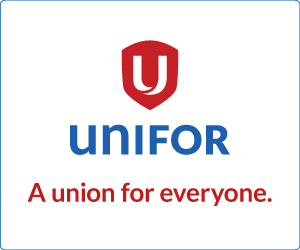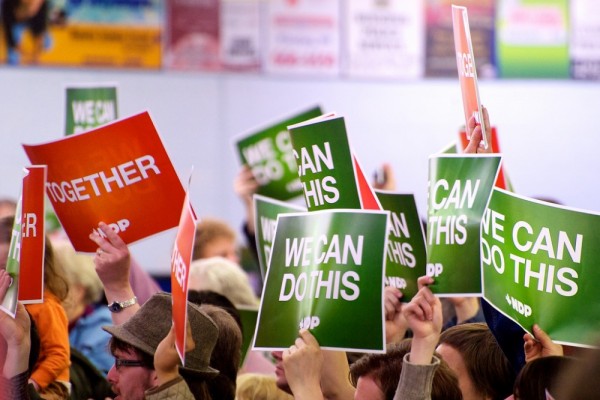Trudeau’s ‘middle class tax cut’ is a sham

Justin Trudeau unveiled his full election campaign in early October, 2019, which included a new Canada Child Benefit and reduced income tax for the middle class. Photo from Twitter.
In the 2019 federal election last fall, both Justin Trudeau’s Liberals and Andrew Scheer’s Conservatives ran on a few broad policies shared in common, showing the general consensus that exists between their two parties. This included a shared fervency for tar sand pipelines, but just as prominent was a “middle class tax cut” which would ostensibly put money back into the pockets of hard-working Canadians.
However, because the Canadian political and pundit class has no coherent understanding of what the middle class is and who comprises it, the chief beneficiaries of these cuts would not necessarily be who Canadians felt was reasonably “middle class”.
During the election, organizations like the Canadian Centre for Policy Alternatives examined both the Trudeau and Scheer tax cuts, and while they found that the Trudeau plan was less regressive than what Scheer offered—because it tailed off the benefits for the highest earners—many of the benefits under the Trudeau plan still went to well off people. This, when combined with the fact that the programs would cost approximately $5.5 billion a year, and not offer much of a direct benefit to anyone, led the CCPA and others to question the value of these tax cuts in comparison to other potential spending options.
Since the election, the Liberals have emphasized this tax cut as one of their earliest priorities in the minority government, but increased examination of the plan has exposed its high cost and propensity to benefit well-off people.
A recent Globe and Mail report by Bill Curry not only pointed out that the Liberal tax cut would have an annual cost overrun of $1.2 billion, but that the people finding the greatest benefits are among Canada’s higher earners:
Individuals with incomes between $103,018 and $159,694 will be $347 better off. Those with incomes between $51,510 and $103,017 will receive $337. People earning $159,695 to $227,504 are next in line, with a $257 tax cut. Those with incomes between $15,001 and $51,509 will receive $211, and individuals with incomes below $15,000 will save one dollar, on average.
As we can see, the ‘middle class tax cut’ benefits low six-figure earners most of all, and benefits those above $160,000 more than those making under $52,000, the poorest of whom will literally only see one dollar of benefit.
While the specific definition of middle class in Canada may not be ironclad, the Liberals often emphasize the class and those working hard to join it, the latter of whom are clearly short-changed here. According to Statistics Canada, Canada’s median individual income is $35,000, and the median family income is $92,700. This means that individuals seeing the biggest benefits make more than the median family on their own, and many times the median individual.
And this explains part of the issue here: Because Justin Trudeau and his Liberal Party have spent so much political capital on the mythology of the middle class, they have a vested interest in defining that class as broadly as possible, because it helps them to broaden their electoral appeal, all while handing out benefits to people earning much more than the national average and median. This is why the 2015 Liberal tax cuts, which did not benefit the bottom 75% of tax filers, could be plausibly classified as a progressive cut ‘for the middle class’ instead of a regressive giveaway to the well-off. This is likely the reason why Justin Trudeau and his “Minister for Middle Class prosperity” Mona Fortier can’t—or choose not to—define the middle class. This is also how Finance Minister Bill Morneau can lie through his teeth and say that these proposed cuts “will help those people that are most in need of help and that’s important for the future of our country.”
This goes to show that when push comes to shove, both the Trudeau Liberals and Scheer Conservatives were unwilling to use the tax system and public purse to pursue the goal of equity in the last election and since.
But Jagmeet Singh and the NDP were. During the election, Singh and the NDP campaigned heavily on the idea of raising taxes, not just on high incomes, but on large corporations, on capital gains, and most significantly, on 1% of all wealth held by those people worth $20 million and more. That last tax alone would have raised $70 billion over the next decade, which could have been used to fund everything from pharmacare to childcare to postsecondary education.
And even after the election, Singh and the NDP have been willing to compromise with Trudeau in a way to ensure his proposed tax cut actually helps the middle class, all while shifting revenue to more equitable and efficient social means. The NDP’s plan is to limit the tax cut to those people earning $90,000 or less, meaning that all the benefits would go to people making what most would call a middle-class salary. The savings here would likely amount to $1.6 billion or more, which would be more than sufficient to cover the NDP’s proposed dentalcare plan from the 2019 election, which would have covered more than four million low- and middle-income Canadians without dental treatment access.
Indeed, the NDP’s proposed dental plan’s ongoing costs would be lower than the estimated overrun cost of the Trudeau tax cut. Nonetheless, The Liberals have—at least thus far—seemed unwilling to implement such a compromise aimed at helping Canada’s most vulnerable.
This is ultimately why Trudeau’s middle-class tax cut, as well as his broader conception of the middle class itself, is a smokescreen to obscure class realities and inequalities in Canada. This allows him to simultaneously claim he’s standing with the 80% of Canadians who are part of this gargantuan class without a definition, all while funnelling benefits disproportionately to well-off people instead of ensuring basic social services for the neediest Canadians.
Christo Aivalis is a SSHRC Postdoctoral Fellow in the Department of History at the University of Toronto. He is a YouTube political commentator, and has made frequent appearances the CBC and CTV. He has also written for sources including Maclean’s, The Globe and Mail, and The Washington Post.










